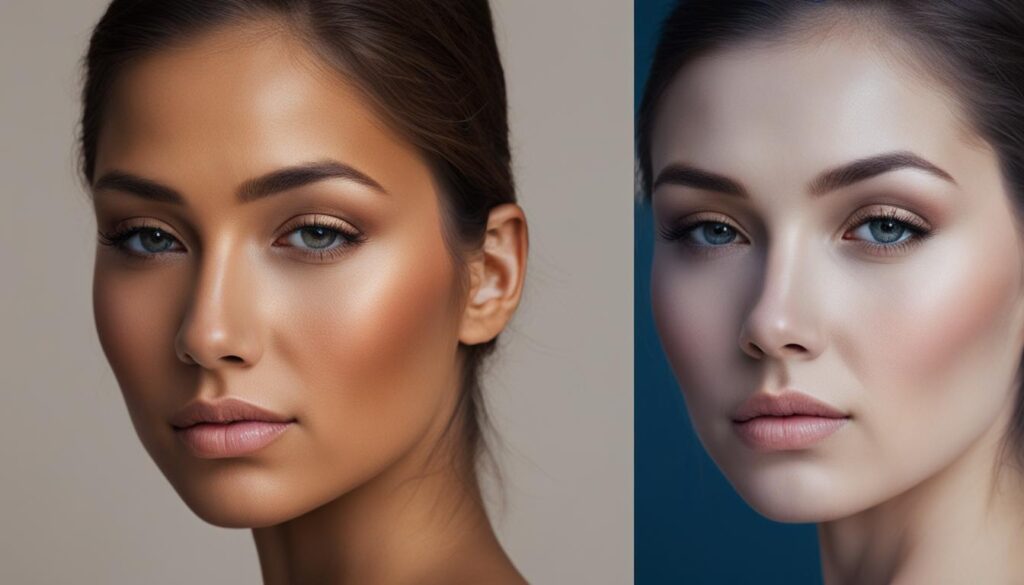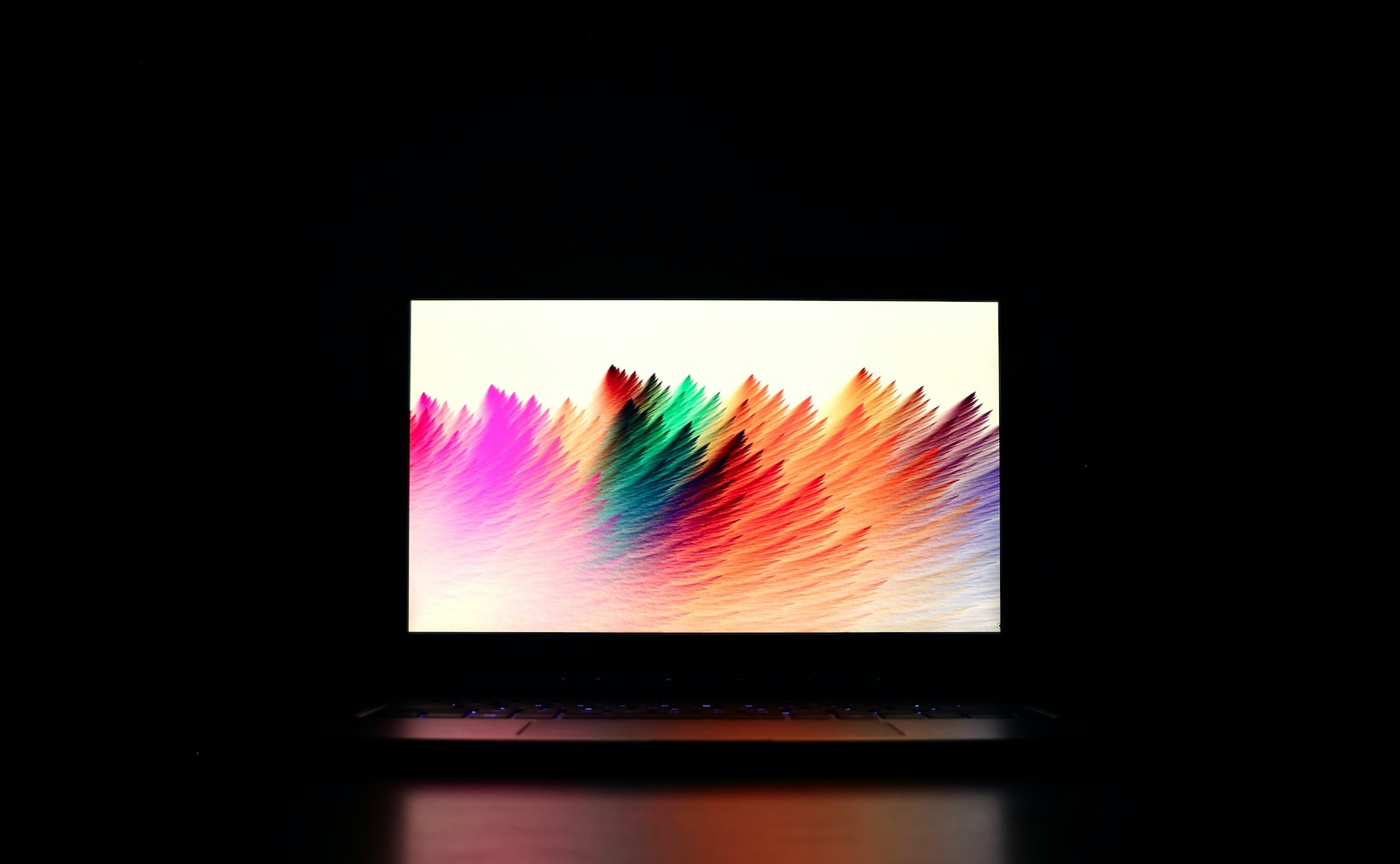Retouching and photo manipulation are often used interchangeably, but there are significant differences between the two. Retouching involves making color and exposure adjustments to refine the original image, while photo manipulation involves altering elements or adding new elements to the image.
Photo editing tools like cropping, white balance, exposure, and sharpness adjustments are fundamental to retouching, while photo manipulation requires more advanced software like Photoshop to merge multiple photos, replace backgrounds, and create new elements. Retouching is more common and accessible, while photo manipulation requires specialized skills and software expertise.
Key Takeaways:
- Retouching focuses on refining the original image through color and exposure adjustments.
- Photo manipulation involves altering or adding elements to the image using advanced software like Photoshop.
- Retouching is more accessible and commonly used, while photo manipulation requires specialized skills and expertise.
The Basics of Photo Editing
Photo editing is a fundamental aspect of image enhancement and plays a crucial role in perfecting photographs. It involves a range of adjustments that improve the quality and visual appeal of an image. From simple cropping to advanced color correction, photo editing allows photographers and designers to refine their images and achieve a specific look.
To begin the photo editing process, the image is assessed for any necessary improvements. This can include adjusting the white balance and exposure to ensure accurate color representation and optimal brightness. Additionally, contrast and sharpness adjustments may be made to enhance the overall clarity and detail of the image.
Utilizing basic smartphone tools or advanced editing software like Adobe Photoshop, photo editing can be accessible to anyone with a desire to enhance their images. AI-powered tools have also made the process more user-friendly, allowing for quick and efficient photo editing.
Table: Common Photo Editing Techniques
| Technique | Description |
|---|---|
| Cropping | Removing unwanted or distracting elements by trimming the edges of the image. |
| White Balance Adjustment | Correcting color casts and ensuring accurate color representation. |
| Exposure Correction | Adjusting the brightness and darkness levels to achieve the desired exposure. |
| Color Correction | Modifying color tones and hues to create a desired color palette. |
| Sharpening | Enhancing the clarity and crispness of the image. |
Overall, photo editing is an essential tool for photographers, designers, and anyone looking to enhance the quality and visual impact of their images. With a variety of techniques and user-friendly tools at our disposal, achieving stunning results is more accessible than ever.
Exploring Photo Manipulation
Photo manipulation is a complex form of digital editing that goes beyond simple adjustments. It involves altering and adding elements to an image, allowing for more creative expressions and imaginative visuals. With the help of advanced software like Photoshop, skilled editors can merge multiple photos, replace backgrounds, and manipulate various elements to create stunning and unique compositions.
One common technique in photo manipulation is sky replacement, where a dull or overcast sky is replaced with a more visually appealing one. This can dramatically change the mood and atmosphere of the image. Another technique is adding lights or enhancing existing ones, which can create a more vibrant and dynamic scene. Additionally, photo manipulation can be used to remove unwanted objects or dust from a photo, resulting in a cleaner and more polished final image.
Photo manipulation requires precision and attention to detail. It often involves pixel-level editing and requires a deep understanding of the software and tools being used. While photo editing focuses on making overall improvements to an image, photo manipulation offers endless creative possibilities, making it a popular choice for product photography, advertising campaigns, and creative projects where a unique and imaginative visual is desired.
To better understand the differences between photo editing and photo manipulation, let’s take a look at the following table:
| Photo Editing | Photo Manipulation | |
|---|---|---|
| Objective | Improving image quality | Creating new and imaginative visuals |
| Tools | Basic editing software | Advanced software like Photoshop |
| Skills | Accessible to anyone | Requires expertise in pixel-level editing |
| Time | Quick and efficient | More time-consuming |
| Applications | Commonly used for basic improvements | Used in product photography and creative projects |
The Key Differences Between Photo Editing and Photo Manipulation
When it comes to working with digital images, understanding the difference between photo editing and photo manipulation is crucial. While both techniques involve making changes to an image, they have distinct goals and approaches. Let’s explore the key differences between photo editing and photo manipulation.
Photo Editing
Photo editing focuses on enhancing and improving the overall quality of an image. It involves adjustments such as color correction, cropping, exposure and contrast fine-tuning, and sharpening. Photo editing is typically done using basic tools and software, and it aims to refine the original image while maintaining its authenticity. It is commonly used for basic improvements and adjustments, making images visually appealing, and achieving a specific look or style.
Photo Manipulation
On the other hand, photo manipulation goes beyond basic adjustments and involves more extensive changes to the image. It requires advanced software like Photoshop and involves altering elements or adding new elements to the image. Photo manipulation techniques include merging multiple photos, replacing backgrounds, and adding or removing elements. Photo manipulation offers more creative possibilities and is often used in advertising, product photography, and creative projects.
While both photo editing and photo manipulation are valuable tools in the digital image editing process, they serve different purposes and require different levels of expertise and software. Understanding these differences allows photographers, designers, and marketers to choose the right approach for their specific needs and achieve the desired results.
| Photo Editing | Photo Manipulation |
|---|---|
| Focuses on enhancing overall image quality | Allows for more extensive changes and additions |
| Uses basic tools and software | Requires advanced software like Photoshop |
| Can be done by anyone with basic training | Requires specialized skills and expertise |
| Refines the original image while maintaining authenticity | Offers more creative possibilities and imaginative visuals |
Understanding Photo Retouching
Photo retouching is a specialized technique used to enhance specific areas of an image, aiming to achieve a more polished and visually appealing final result. It involves making targeted adjustments to improve the overall appearance of the subject or objects in the photograph.
One of the primary focuses of photo retouching is to remove imperfections from the skin, such as blemishes, wrinkles, or scars. With the use of advanced software like Photoshop, retouchers can carefully smoothen the skin without losing its natural texture. Additionally, photo retouching can involve whitening teeth, retouching hair, brightening eyes, and even reshaping certain elements to create a more flattering composition.
Photo retouching requires skilled hands and an eye for detail. It goes beyond basic editing and requires the ability to identify areas that need improvement and apply enhancements while maintaining a realistic and natural look. Skilled retouchers possess knowledge of advanced retouching techniques, such as frequency separation, dodging and burning, and advanced color correction, which allow them to achieve professional-quality results.
The Importance of Photo Retouching
Photo retouching plays a crucial role in various industries, including fashion, beauty, advertising, and product photography. In these fields, the goal is often to present subjects or products in the best possible light, without distractions or imperfections that could detract from the intended message or impact.
In the fashion and beauty industry, retouching is commonly used to create flawless images of models and products. It helps to remove any imperfections on the skin, enhance the appearance of makeup and hairstyles, and bring out the desired attributes of the subject. Product photographers utilize retouching techniques to ensure that their images accurately represent the product and its features, focusing on enhancing details, eliminating background distractions, and ensuring the product looks appealing to potential customers.
Overall, photo retouching is a valuable tool in the hands of skilled professionals, allowing them to elevate the quality and impact of their images. Through precise and strategic adjustments, retouchers can enhance the visual appeal, convey the intended message, and create captivating visuals that leave a lasting impression.

| Photo Editing | Photo Retouching |
|---|---|
| Focuses on overall improvements to image quality | Targets specific areas for enhancement |
| Includes adjustments like cropping, color correction, and exposure | Addresses imperfections, such as blemishes, wrinkles, and discoloration |
| Can be done using basic software and requires minimal expertise | Requires advanced software like Photoshop and skilled retouchers |
| Accessible to anyone and can be done quickly | Requires specialized knowledge and attention to detail |
| Used for general image enhancement and stylization | Used to refine specific elements and create a more polished look |
Differentiating Between Photo Editing and Photo Retouching
In the world of digital photography, photo editing and photo retouching are two distinct techniques used to enhance images. While these terms are often used interchangeably, they refer to different processes with specific goals and applications. Understanding the differences between photo editing and photo retouching is essential for photographers and designers to choose the right approach for their projects.
Photo Editing:
Photo editing encompasses a range of adjustments made to improve the overall quality and visual appeal of an image. This process involves techniques such as color correction, cropping, exposure adjustment, and sharpening. The goal of photo editing is to enhance the image as a whole, refining its composition, balance, and tone. It is typically done using software tools like Adobe Lightroom or free smartphone apps. Photo editing is accessible to anyone and can be learned with basic training.
Photo Retouching:
Unlike photo editing, photo retouching is a more targeted approach that focuses on making localized adjustments to specific areas of an image. This technique is commonly used to remove imperfections, smoothen skin, enhance facial features, and make other fine-tuned adjustments. Photo retouching requires advanced software like Adobe Photoshop and skilled hands to achieve professional results. It demands precision and attention to detail to ensure subtle improvements without overdoing the alterations.
The Differences:
The key differences between photo editing and photo retouching lie in their objectives and the extent of changes made to the image. Photo editing aims to improve the overall quality and visual appeal of the image, while photo retouching targets specific areas to enhance or correct details. Photo editing is more accessible and can be done by anyone with basic training, while photo retouching requires advanced expertise and specialized software. Both techniques serve different purposes and play crucial roles in achieving desired results in photography and design projects.
Table: Differences Between Photo Editing and Photo Retouching
| Aspect | Photo Editing | Photo Retouching |
|---|---|---|
| Objective | Improving overall image quality | Enhancing specific areas or details |
| Techniques | Color correction, cropping, exposure adjustment | Spot removal, skin smoothing, feature enhancement |
| Software | Adobe Lightroom, smartphone apps | Adobe Photoshop, advanced retouching software |
| Accessibility | Accessible to anyone with basic training | Requires advanced expertise and software |
Understanding the distinctions between photo editing and photo retouching allows photographers and designers to choose the right technique for their specific needs. Whether it’s enhancing an entire image or refining specific details, both approaches offer valuable tools for achieving impactful and visually stunning results in the world of digital imagery.
Choosing Between Photo Editing and Photo Retouching
When it comes to enhancing images, understanding whether to use photo editing or photo retouching is essential. Both techniques have their specific purposes and can help achieve different outcomes. By assessing the needs of the image and the desired results, photographers, designers, and marketers can make an informed decision.
Photo editing is typically used for broader improvements to the overall image quality. It involves adjustments like color correction, cropping, and exposure enhancements. This technique is accessible to anyone and can be done quickly, making it ideal for basic image enhancement tasks.
On the other hand, photo retouching is a more targeted approach that aims to enhance specific areas or elements of an image. It is commonly used to remove imperfections, like blemishes or wrinkles, and enhance details such as skin texture or eye brightness. Photo retouching requires advanced software and expertise, as it involves intricate adjustments and masking techniques.
When to Use Photo Editing:
- Overall image enhancement
- Color correction and tonal adjustments
- Cropping and composition adjustments
When to Use Photo Retouching:
- Targeted enhancements of specific areas or elements
- Removal of imperfections or distractions
- Enhancement of details and textures
By considering the goals and limitations of each technique, it’s possible to choose the approach that best suits the specific needs of the image. Discussing the desired level of enhancements with clients or art directors is also crucial to ensure the final result aligns with their expectations.
| Photo Editing | Photo Retouching |
|---|---|
| Improves overall image quality | Enhances specific areas or elements |
| Accessible and can be done quickly | Requires advanced software and expertise |
| Used for basic adjustments like cropping and color correction | Used for removing imperfections and enhancing details |
| Focuses on the entire image as a whole | Targets specific areas or elements for enhancement |
Conclusion
In conclusion, photo editing and photo manipulation are distinct techniques that offer different ways to enhance and alter images. Photo editing focuses on improving the overall quality of an image, using basic tools that are accessible to anyone. On the other hand, photo manipulation involves more advanced techniques and software to create new elements and imaginative visuals.
While photo editing is suitable for making general improvements such as color correction and cropping, photo manipulation offers more creative possibilities by allowing the addition or removal of elements in an image. It requires specialized skills and expertise in advanced software like Photoshop.
Photo retouching, a specialized technique, focuses on enhancing specific areas of an image, such as removing imperfections and enhancing features like skin and eyes. It requires attention to detail and advanced knowledge of tools and software.
Understanding the differences between these techniques is essential for photographers, designers, and marketers, as it allows them to choose the right approach for their specific needs. Whether it’s improving image quality, creating imaginative visuals, or enhancing specific elements, the choice between photo editing, photo manipulation, or photo retouching depends on the goals and limitations of each technique.
FAQ
What is the difference between retouching and photo manipulation?
Retouching involves making color and exposure adjustments to refine the original image, while photo manipulation involves altering elements or adding new elements to the image.
What tools are used in photo editing?
Photo editing tools include cropping, white balance, exposure, and sharpness adjustments.
What software is required for photo manipulation?
Photo manipulation requires advanced software like Photoshop to merge multiple photos, replace backgrounds, and create new elements.
How accessible are retouching and photo manipulation?
Retouching is more common and accessible, while photo manipulation requires specialized skills and software expertise.
What is the goal of photo editing?
The goal of photo editing is to improve the quality of an image and achieve a specific look.
What does photo manipulation allow for?
Photo manipulation allows for more creative expressions and the creation of new and imaginative visuals.
How do photo editing and photo manipulation differ in terms of time and precision?
Photo editing is accessible to anyone and can be done quickly, while photo manipulation requires skilled hands and takes more time.
What is the main difference between photo editing and photo manipulation?
Photo editing focuses on improving image quality with basic tools, while photo manipulation involves more extensive changes and advanced software.
What is the purpose of photo retouching?
Photo retouching aims to enhance specific elements of an image and achieve the editor’s artistic vision.
How do photo editing and retouching differ?
Photo editing involves making broader changes to the image, while retouching focuses on making localized adjustments to specific areas.
Which technique is more accessible?
Photo editing is more accessible and can be done with basic training, while retouching requires advanced expertise.
How do I choose between photo editing and retouching?
The choice depends on the specific needs of the image, with editing generally used for basic improvements and retouching for targeted adjustments.
 Skip to main content
Skip to main content


